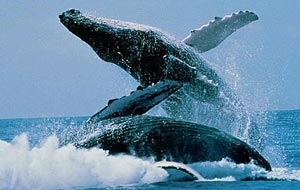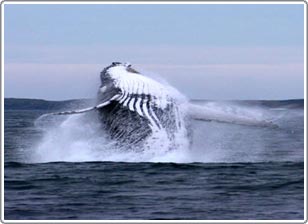Whale brains have a human-like part
The hump on the whale's back has an amazingly complex brain, which raises questions about how these marine mammals have evolved.
 (Photo: Greenpeace.org) According to US researchers, the whale's back hump has a type of brain cell that is found only on humans, on large primates, and animals Other emulsive sea like dolphins. Scientists say this may mean that whales are much smarter than what people once recognized about them.
(Photo: Greenpeace.org) According to US researchers, the whale's back hump has a type of brain cell that is found only on humans, on large primates, and animals Other emulsive sea like dolphins. Scientists say this may mean that whales are much smarter than what people once recognized about them.
And this assumes the basis for complex or evolutionary brains that are more than once, or that are not used by most animals. According to researchers' reports in the Journal of Anatomy Records, this finding may help explain some whale activities, such as complex communication skills, formation of interlocking blocks. smart, collaboration, cultural communication and use of tools.
Professor Patrick Hof and colleagues from Mount Sinai Medical School have discovered a type of cell called a rhombic neuron in the whale cortex. They found these cells in areas corresponding to areas found in humans and large primates. Although the function of these rhombus neurons is not well understood, they may be related to cognition - learning, remembering and recognizing the world. These spindle cells can be affected by dementia and other brain-impairing disorders such as autism and schizophrenia.
Complex social models
Researchers have found rhombic neurons in the same location in toothed whales with the largest brains, which the researchers suggest suggests that these cells may be related to brain size.
Toothed whales, such as eel fish, are often considered smarter than whale-like whales like humpback whales and blue whales, which help filter the water for their food.
Back humps are also similar in structure to the ' islands ' in the cerebral cortex, also found in some other mammals.

(Photo: Moonshadow)
The researchers said these ' islands ' may have evolved to enhance fast and effective communication between neurons.
The researchers say the rhombus neurons may appear for the first time in the common ancestor of the giant human, human and primate species 15 million years ago. They are not found in smaller primates or monkeys.
The researchers say that in mammal mammals, they may have evolved earlier, possibly soon enough to reach 30 million years ago.
How do these cells evolve?
The researchers say either these rhombus neurons are kept only in animals with the largest brains or that they evolve many times independently.
The researchers wrote in the report that: 'Despite the relative scarcity of information on many marine mammals, it is important to note in this context that the sperm whale and fish are pigs and certainly humped whales on their backs, exposing complex social models including complex communication skills, union formation, cooperation, cultural communication and use tool. Therefore, it is possible that some of these possibilities are related to the corresponding tissue complexity in brain formation in mammal mammals and those of the human family. '
Route
- Search for the whale 'Forever Alone' most on Earth
- 100 brains disappear mysteriously
- Successfully developed miniature human brains in the laboratory
- Super computer 'human brain'
- Tracking whales - Mysterious whale whale cropping event (Part I)
- Smart 'other development' human brain
- The reason that pets often have reduced brain
- Initial success in connecting human brains together
- What happens if you get swallowed by a whale?
- How does the brains of geniuses work? (2)
- Wikie: The first human-speaking whale in human history
- Heroic scene of massacre of whales, sea water changed color
 Surprised: Fish that live in the dark ocean still see colors
Surprised: Fish that live in the dark ocean still see colors Japan suddenly caught the creature that caused the earthquake in the legend
Japan suddenly caught the creature that caused the earthquake in the legend A series of gray whale carcasses washed ashore on California's coast
A series of gray whale carcasses washed ashore on California's coast Compare the size of shark species in the world
Compare the size of shark species in the world Recreating unprecedented depth and detail inside volcanoes
Recreating unprecedented depth and detail inside volcanoes  Thousands of skeletons and weapons reveal battle 3,250 years ago
Thousands of skeletons and weapons reveal battle 3,250 years ago  AI can predict 'tipping points' for future disasters
AI can predict 'tipping points' for future disasters  Undersea fiber optic cables can be used to record whales and see what they're doing
Undersea fiber optic cables can be used to record whales and see what they're doing  The absolute advantage of light quantum chips: Shorten 9,000 years of computation to 36 millionths of a second
The absolute advantage of light quantum chips: Shorten 9,000 years of computation to 36 millionths of a second  This is not a chicken, this is the first bird to be domesticated by humans
This is not a chicken, this is the first bird to be domesticated by humans 